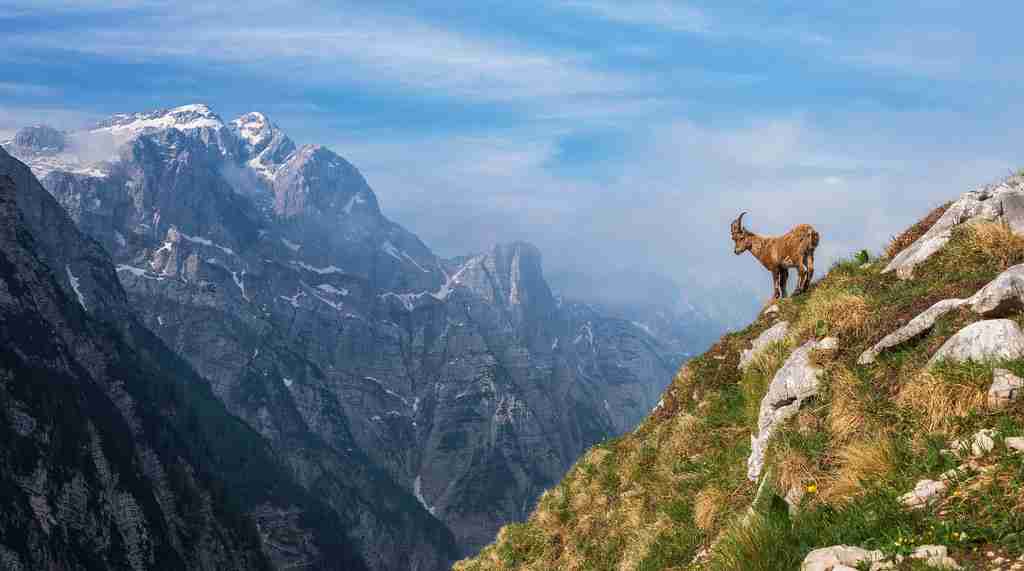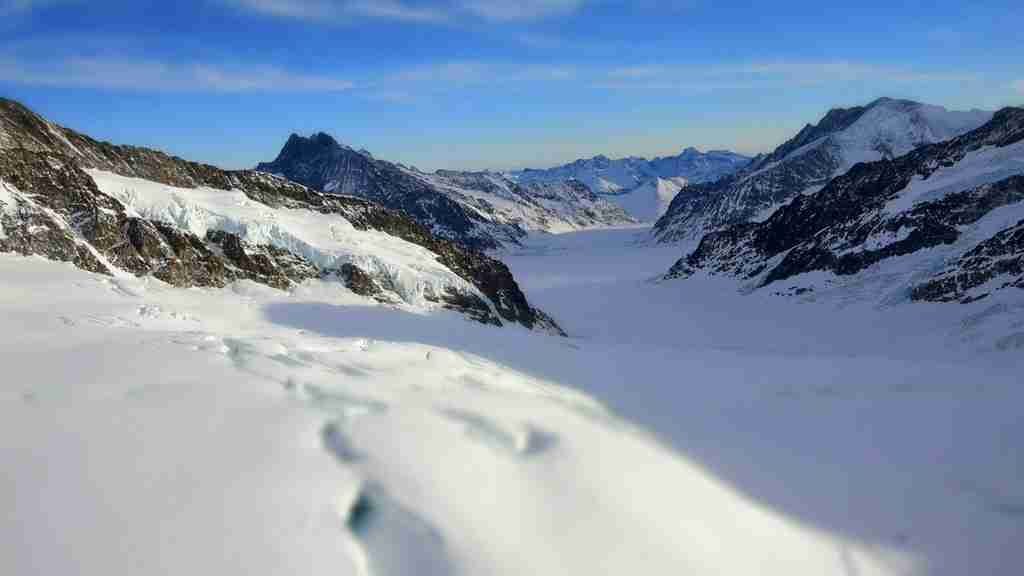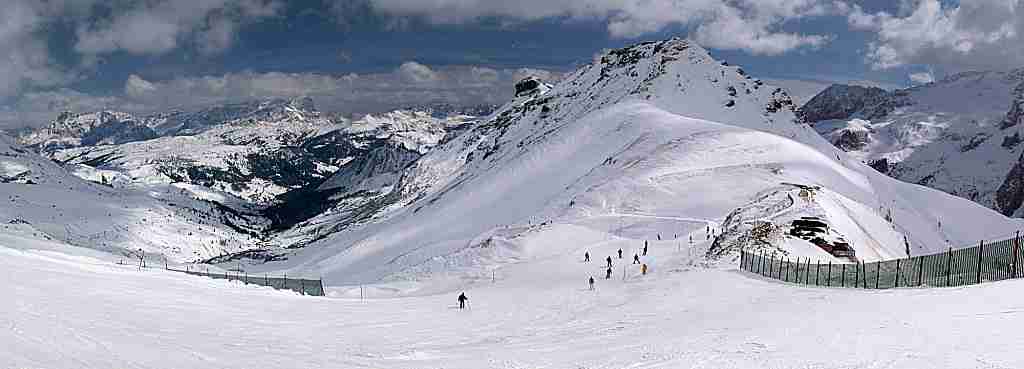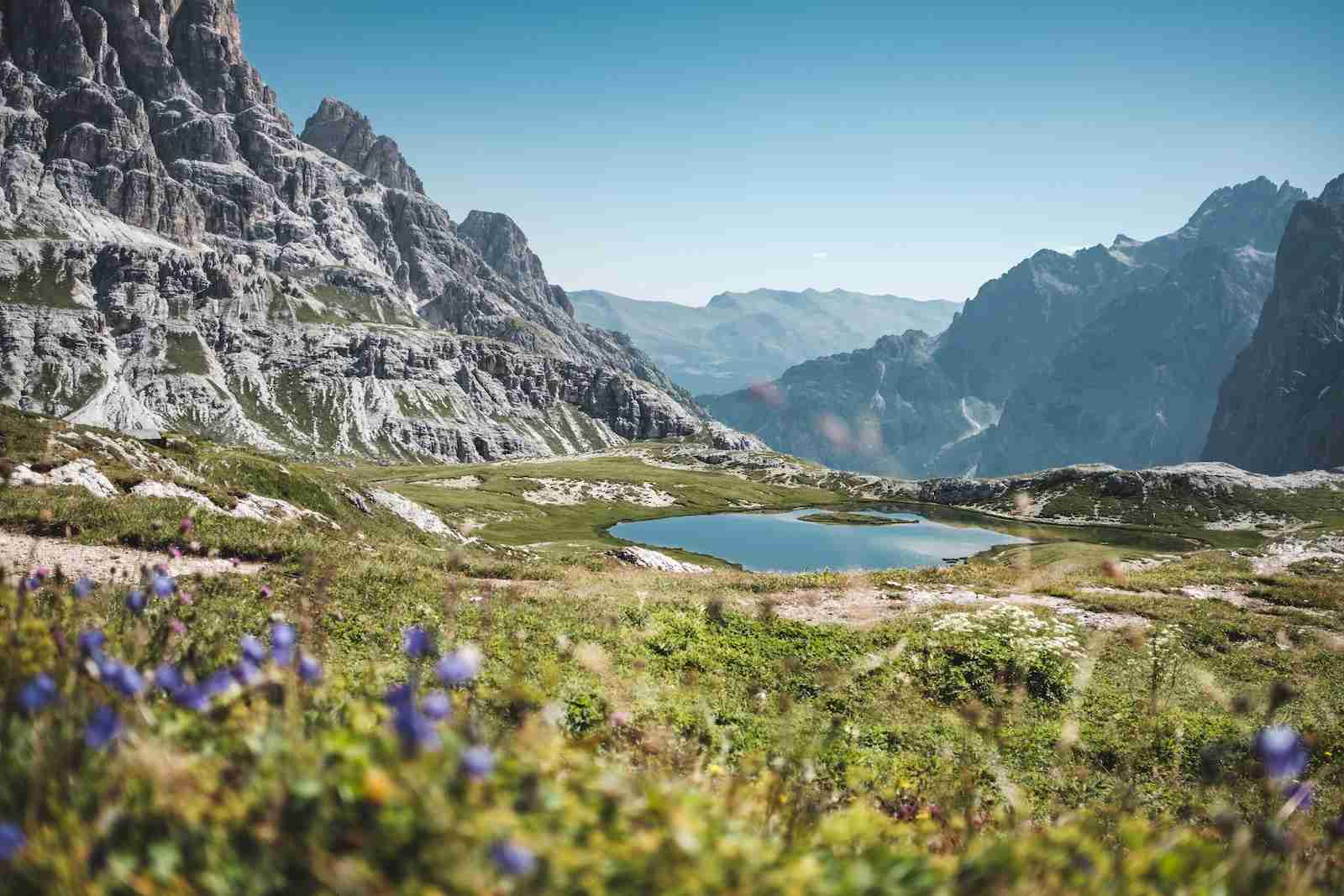26 Fun Facts About Alps | From Glaciers to Edelweiss
1. The Alps span eight countries, including France, Switzerland, and Austria.
The Alpine mountain range, known as the “Roof of Europe,” sprawls across eight countries, weaving a stunning tapestry of diverse landscapes and cultures.
From the picturesque slopes of the French Alps to the pristine lakes of Switzerland, this transboundary marvel fosters a rich mosaic of traditions and languages. This international tapestry reflects the harmonious coexistence of nations bound together by the majesty of the Alps.
2. What is the highest mountain in the Alps?
Mont Blanc, Western Europe’s crowning jewel, rises majestically as the Alps’ highest peak, reaching an elevation of 4,808 meters (15,774 feet). This snow-capped giant offers breathtaking panoramic views, attracting mountaineers and adventurers from around the globe.
As a beacon of natural beauty and a symbol of human determination, Mont Blanc holds a place of honor in the hearts of those who venture into the realm of Alpine heights.
3. The Alpine region houses numerous picturesque lakes like Lake Geneva.
Beyond its towering peaks, the Alpine region boasts a collection of picturesque lakes, with Lake Geneva standing out as a shimmering gem nestled between Switzerland and France.
Surrounded by vineyards and charming towns, these Alpine lakes offer tranquility and stunning vistas. Lake Geneva, in particular, reflects the enchanting blend of natural beauty and cultural richness that defines the Alpine experience.
4. Ibex, chamois, and marmots are iconic Alpine wildlife species.

The Alps host a diverse array of fauna, with ibex, chamois, and marmots emerging as iconic denizens of this rugged terrain.
These resilient creatures navigate the steep slopes and alpine meadows, adding life and vitality to the picturesque landscape. The Alpine ecosystem’s delicate balance hinges on the adaptability and endurance of these remarkable wildlife species.
5. The Alps are a prime destination for skiing and snowboarding enthusiasts.
Renowned as a winter sports haven, the Alps beckon skiing and snowboarding enthusiasts to carve through their powder-covered slopes.
From the world-class resorts of Verbier to the challenging runs of Kitzbühel, the Alpine slopes cater to every skill level. This winter wonderland not only offers adrenaline-pumping adventures but also provides a scenic backdrop for those seeking the perfect blend of excitement and natural beauty.
6. The Alpine Convention promotes sustainable development and conservation in the region.
At the heart of Alpine governance, the Alpine Convention stands as a commitment to sustainable development and environmental conservation.
This international treaty, signed by the Alpine countries, aims to balance human activities with the preservation of the region’s natural beauty. Through collaborative efforts, the convention strives to ensure the Alps remain a pristine sanctuary for generations to come.
7. The Alps formed over millions of years due to tectonic activity.
The geological history of the Alps unfolds over millions of years, shaped by powerful tectonic forces that sculpted this mountainous masterpiece.
The collision of tectonic plates gave rise to the majestic peaks and deep valleys, creating a breathtaking topography that captivates geologists and nature enthusiasts alike. The Alps stand as a testament to the ever-evolving canvas of Earth’s geological story.
8. The name “Alps” is derived from the Latin word “albus,” meaning white.
The etymology of the Alps traces back to the Latin word “albus,” meaning white, aptly capturing the snow-covered expanse that blankets these majestic mountains.
This nomenclature not only paints a vivid picture of the region’s winter wonderland but also pays homage to the enduring beauty that graces the landscape throughout the year. The name serves as a poetic reminder of the timeless allure found in the alabaster peaks and glaciers that define the Alps.
9. The Gotthard Base Tunnel is the world’s longest railway tunnel, spanning the Alps.
The Gotthard Base Tunnel, a marvel of modern engineering, stretches beneath the heart of the Alps, earning the title of the world’s longest railway tunnel.
This subterranean feat spans a staggering 57 kilometers, seamlessly connecting northern and southern Europe. Its construction represents a triumph of innovation, providing a swift and efficient link through the formidable barrier of the Alps.
10. The Alps provide a habitat for endangered species like the lynx.
Amidst the Alpine wilderness, the elusive lynx finds refuge, representing the delicate balance of predator and prey.
As an endangered species, the lynx’s presence highlights the importance of conservation efforts in maintaining the Alpine ecosystem. Its elusive nature adds an air of mystery to the alpine forests, underscoring the need to protect these habitats for the benefit of biodiversity.
11. The Alps contain diverse ecosystems, from alpine meadows to dense forests.
Within the Alps, a tapestry of diverse ecosystems unfolds, ranging from the floral abundance of alpine meadows to the hushed mysteries of dense forests.
This ecological variety supports a rich array of flora and fauna, creating a mosaic of life that adapts to the ever-changing altitudes and climates. The intricate balance of these ecosystems adds depth to the natural charm of the Alps.
12. The Matterhorn, a famous peak, is often referred to as the “Mountain of Mountains.”
The Matterhorn, an iconic pyramid-shaped peak, earns the moniker “Mountain of Mountains” for its unparalleled beauty and mountaineering challenges.
Towering between Switzerland and Italy, its distinctive silhouette has become synonymous with Alpine grandeur. As a magnet for climbers and photographers alike, the Matterhorn’s mystique adds a touch of timeless allure to the Alpine skyline.
13. Alpine architecture features charming chalets and traditional mountain designs.
The charm of the Alps extends beyond nature to its quaint villages and Alpine architecture, characterized by charming chalets adorned with wooden balconies and steep-pitched roofs.
These structures, born from a blend of tradition and practicality, create an inviting atmosphere that complements the breathtaking surroundings. Alpine architecture serves as a cultural testament, seamlessly integrating human habitation into the stunning mountain landscape.
14. The region has a rich cultural heritage with influences from various European nations.
Enriched by centuries of cultural exchange, the Alpine region boasts a tapestry of traditions influenced by various European nations.
From the lively festivals of Bavaria to the refined arts of French Alpine communities, this cultural mosaic reflects the interconnected history of the region. The Alpine heritage stands as a testament to the resilience of local communities and their ability to preserve and celebrate their unique identity.
15. The Eiger, Mönch, and Jungfrau are a trio of iconic peaks in the Bernese Alps.
The Bernese Alps host a triumvirate of iconic peaks—Eiger, Mönch, and Jungfrau—standing as a testament to nature’s grandeur.
These towering sentinels, adorned with glaciers and rocky ridges, create a breathtaking panorama that captivates onlookers. The trio’s prominence in the Bernese skyline adds a touch of drama and mystique to the Alpine experience.
16. Edelweiss, a rare flower, is a symbol of the Alpine region.

The delicate edelweiss, a rare and cherished flower, serves as a symbol of the Alpine region’s enduring beauty and resilience.
Nestled in high-altitude meadows, this iconic bloom has inspired myths and legends, becoming a cultural emblem synonymous with alpine purity. Its presence not only graces the landscape with ethereal beauty but also evokes a sense of nostalgia and connection to the rich heritage of the Alps.
17. The Alps were a significant barrier for trade and communication in ancient times.
In antiquity, the Alps presented a formidable barrier, challenging traders and travelers with treacherous terrain.
This natural barrier shaped historical events, influencing trade routes and the movement of civilizations. The strategic importance of crossing the Alps echoes in the historical narratives of Hannibal’s elephants and the Roman legions, highlighting the enduring role these mountains played in shaping human history.
18. The Alpine Ibex is known for its impressive, curved horns, which is one of the fun facts about Alps.
The Alpine Ibex, a symbol of rugged Alpine terrain, is renowned for its distinctive, curved horns.
These majestic herbivores navigate steep cliffs with grace, showcasing the adaptability of Alpine wildlife. The Ibex’s impressive horns, a product of evolutionary prowess, stand as a testament to the unique adaptations required for survival in the challenging alpine environment.
19. The Dolomites, part of the Southern Limestone Alps, boast unique rock formations.
Nestled within the Southern Limestone Alps, the Dolomites captivate with their unique rock formations and towering spires.
These pale mountains, composed of dolomite rock, create a surreal landscape that shifts in hues throughout the day. Recognized as a UNESCO World Heritage site, the Dolomites stand as a geological masterpiece, inviting adventurers to explore their dramatic peaks and scenic valleys.
20. Alpine glaciers, like the Aletsch Glacier, are awe-inspiring natural wonders.

The Alps are adorned with awe-inspiring natural wonders, and the Aletsch Glacier stands as a testament to the majesty of Alpine glaciers.
As the largest glacier in the Alps, it weaves through valleys, leaving a trail of pristine ice in its wake. This icy giant not only shapes the landscape but also serves as a poignant indicator of the delicate balance between nature’s grandeur and the impact of climate change.
21. Alpine cheeses, like Swiss and French varieties, are world-renowned.
The Alps have left an indelible mark on the culinary world, particularly through their world-renowned cheeses.
From the nutty flavors of Swiss Gruyère to the pungent notes of French Reblochon, Alpine cheeses reflect the terroir of the mountains. These delectable creations not only satisfy the palate but also pay homage to the traditional craftsmanship embedded in Alpine culture.
22. The Via Alpina is a long-distance hiking trail traversing the entire Alpine arc.
For avid hikers seeking the ultimate Alpine adventure, the Via Alpina beckons as a long-distance trail winding through the entire Alpine arc.
Spanning more than 5,000 kilometers, this trek connects eight Alpine countries, offering a diverse tapestry of landscapes and cultures. The Via Alpina stands as a pilgrimage for those yearning to experience the untamed beauty of the Alps step by step.
23. The Aiguille du Midi cable car offers breathtaking views of the French Alps.
Elevating adventurers to dizzying heights, the Aiguille du Midi cable car provides a thrilling ascent to one of the highest peaks in the French Alps.
From its panoramic viewing platforms, visitors are treated to breathtaking vistas of snow-capped peaks and expansive valleys. This engineering marvel not only facilitates access to high-altitude splendors but also stands as a testament to human ingenuity against the backdrop of alpine grandeur.
24. The Sella Ronda is a popular ski circuit in the Dolomites.

Ski enthusiasts flock to the Dolomites to conquer the Sella Ronda, a popular ski circuit that winds its way around the Sella massif.
This exhilarating route offers not only challenging descents but also stunning views of the Dolomite peaks. The Sella Ronda’s reputation as a premier ski destination highlights the Dolomites’ allure as a playground for winter sports enthusiasts..
25. The traditional Alpine sport of yodeling has deep cultural roots.
Embedded in the Alpine cultural tapestry, yodeling is a traditional form of vocal expression that resonates through the mountainous terrain.
Originating as a means of communication across valleys, yodeling has evolved into a cherished musical tradition. This melodic art form not only reflects the close relationship between Alpine communities and their surroundings but also serves as a captivating glimpse into the cultural heartbeat of the region.
26. The AlpTransit project aims to enhance rail connectivity through the Alps.
Addressing the modern need for efficient transportation, the AlpTransit project represents a visionary initiative to enhance rail connectivity through the heart of the Alps.
This ambitious endeavor includes the construction of new rail tunnels, such as the Gotthard Base Tunnel, to facilitate smoother and faster transit. The AlpTransit project stands as a testament to the ongoing efforts to overcome geographical challenges and improve connectivity for both people and goods within the Alpine region.
FAQs
Alpine mountains refer to the vast mountain range system in Europe known as the Alps, characterized by iconic peaks, diverse ecosystems, and a rich cultural heritage.
The Alps comprise numerous majestic mountains, including iconic peaks like Mont Blanc, Matterhorn, Eiger, Mönch, and Jungfrau, contributing to the breathtaking Alpine landscape.
You can find detailed maps of the Alps online, in travel guides, or at local tourist information centers to help plan your exploration of this stunning mountainous region.
The Alps span eight countries, including France, Switzerland, Austria, Italy, Germany, Slovenia, Liechtenstein, and Monaco, creating a diverse and picturesque mountainous region in Europe.
The Alps boast iconic peaks like Mont Blanc, Matterhorn, Eiger, Mönch, and Jungfrau, among many others, creating a spectacular and varied mountainous landscape in Europe.







